基于多目标优化理论的耦合无关恒压输出型LCC/S补偿感应电能传输系统
焦超群 杨 旭 杨俊峰 魏 斌 吴晓康
基于多目标优化理论的耦合无关恒压输出型LCC/S补偿感应电能传输系统
焦超群1杨 旭1杨俊峰1魏 斌2吴晓康2
(1. 北京交通大学电气工程学院 北京 100044 2. 中国电力科学研究院有限公司 北京 100192)
基于传统完全谐振参数设计方法的感应电能传输(IPT)系统只有在发射线圈和接收线圈完全耦合时才能表现出最佳性能。实际的IPT系统多为变耦合系统,耦合系数变化可能导致输出电压大范围波动和效率降低等问题。该文提出一种基于多目标优化理论的补偿拓扑参数设计方法,在耦合系数和负载变化的情况下仍然可以获得相对恒定的输出电压且能够高效运行。首先,利用基波近似分析法建立LCC/S补偿IPT系统的系统方程。其次,以补偿参数为优化变量,以减小输出电压波动、提升系统效率为优化目标,以电感最大通过电流、电容最大承受电压和零电压开关为约束条件建立多目标优化模型。然后,利用多目标粒子群优化(MOPSO)算法求解所建立的多目标优化模型,并得到Pareto最优解集。最后,根据实际需要,从Pareto最优解集中选择合适的补偿方案,并进行仿真分析和实验验证。实验结果表明,优化方案的电压波动率(VFR)约为传统方案的45%,且优化方案的最低传输效率(87.5%)仍大于传统方案的最高传输效率(86.3%)。该方法可用于优化满足耦合和负载无关恒定输出、高效率、零电压开关等特性的补偿拓扑。
感应电能传输 多目标优化 耦合无关恒压输出 多目标粒子群优化(MOPSO)算法 Pareto解集
0 引言
感应电能传输(Inductive Power Transfer, IPT)系统由于具有较高的功率水平和效率特性,已成为无线电能传输(Wireless Power Transfer, WPT)领域的主要研究方向[1-2]。IPT系统具有安全、灵活、可靠、美观等优点,可应用于电动汽车、消费电子、植入式医疗设备、水下电气设备等领域,是替代传统有线充电方式的有效解决方案[3-5]。
基于完全谐振的IPT系统仅在发射和接收线圈完全耦合时才能表现优异的性能[6-7]。然而,线圈之间发生偏移是不可避免的,可能引起系统输出波动较大或效率降低等问题[8-11]。为了在耦合系数变化条件下获得相对恒定的输出并高效运行,专家学者提出了多种解决方案,主要分为控制策略、磁耦合机构设计和补偿拓扑三类[12-13]。其中,控制策略能够得到精确输出,但是当负载和耦合系数在较宽范围内变化时,变换器的调控需求增加,可能会导致控制复杂、效率降低和不稳定等问题[14]。另外,额外增加的变换器也会带来额外的成本、体积和质量。磁耦合机构仅在某个方向偏移时,耦合系数基本保持不变,系统抗偏移范围有限[15]。
补偿拓扑可以降低IPT系统控制复杂度,提升其可靠性和稳定性。基于传统完全谐振补偿参数设计方法的基本补偿拓扑(S/S、S/P、P/S、P/P)不具有抗偏移能力[16],高阶补偿拓扑的抗偏移能力也有限[17-18]。文献[19-20]利用混合型补偿拓扑提升IPT系统的抗偏移能力,一个拓扑的输出增益与耦合系数成正比;另一个拓扑的输出增益与耦合系数成反比。混合型补偿拓扑的增益之和在一定范围内保持相对恒定,但是增加了线圈和补偿元件的数量,系统的成本和复杂性也相应增加。另外,文献[21]提出了重构拓扑方法,以提升系统的抗偏移能力。然而,重构拓扑需要额外的检测电路和控制策略,增加了系统复杂性,降低了运行可靠性。
除了补偿拓扑结构设计,补偿参数优化也能够提升IPT系统的抗偏移能力。文献[22]提出了一种原边感性、副边容性的补偿方法,在宽耦合范围内实现了稳定的输出。文献[23]提出了一种基于枚举法的S/S补偿拓扑参数设计方法,以减小偏移条件下输出电压的波动。文献[24]建立了功率波动的偏微分方程,利用解析法优化了LCC/S补偿参数。然而,以上方法均未考虑IPT系统的传输效率问题。文献[25]提出了一种基于粒子群优化的S/CLC补偿参数设计方法,实现了较高的抗偏移能力和效率。然而,由于采用了加权求和法将多个目标函数合并为一个目标函数,各目标函数的权重需要人为选取,无法精准确定。文献[26]建立了补偿参数多目标优化模型,并利用分支减少优化导航求解器求解所提出非线性优化模型。但该方法仍需建立和求解偏微分方程,建模和求解过程比较复杂。文献[27]提出了一种基于非支配排序遗传算法Ⅲ的拓扑结构和参数同步优化方法。然而,该方法没有进一步分析多目标优化得到的Pareto(帕累托)最优解集,缺乏IPT系统输出电压波动和效率折中方案的分析。
本文突破了传统完全谐振参数设计方法的局限性,将IPT系统补偿参数设计问题转化为多目标优化问题。与单目标优化只能得到唯一解不同,本文建立了多目标优化模型并利用多目标粒子群优化(Multi-Objective Particle Swarm Optimization, MOPSO)算法求解得到了Pareto最优解集。决策者根据实际需要确定各目标权重,从Pareto最优解集中筛选出合适的设计方案,以确保IPT系统在耦合系数和负载变化条件下仍然能够获得相对恒定的输出电压,同时能够高效运行。
1 基于谐振的LCC/S补偿拓扑性能分析
1.1 基于LCC/S补偿拓扑的IPT系统建模

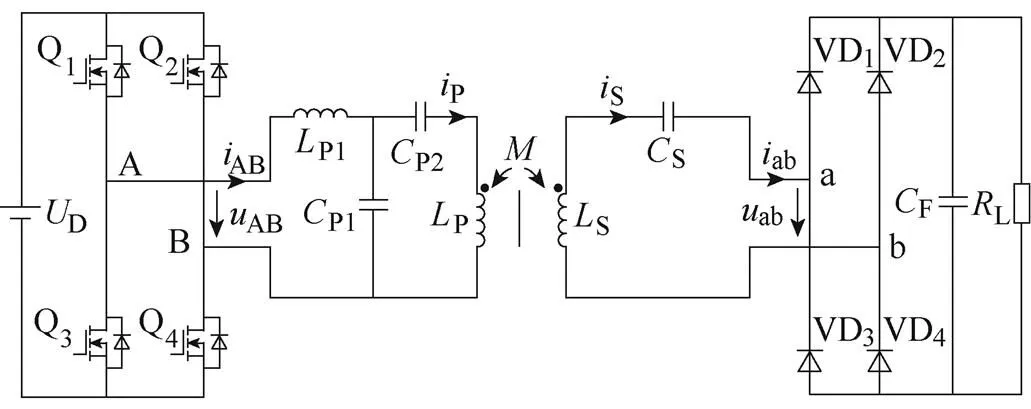
图1 基于LCC/S补偿拓扑的感应电能传输系统
利用基波近似分析(Fundamental Harmonic Approximation, FHA)法对图1所示的IPT系统进行分析。设AB和AB分别为AB和AB的基波有效值,ab和ab分别为ab和ab的基波有效值,P和S分别为发射线圈和接收线圈的电流的有效值。设逆变器的输出电压的调制占空比为50%,则逆变器的输出电压AB以及整流桥的输入交流等效电阻eq满足

根据式(1),可得到基于LCC/S补偿拓扑的IPT系统等效电路如图2所示。基于互感理论建立了该系统的阻抗模型,阻抗定义及其关系可表示为

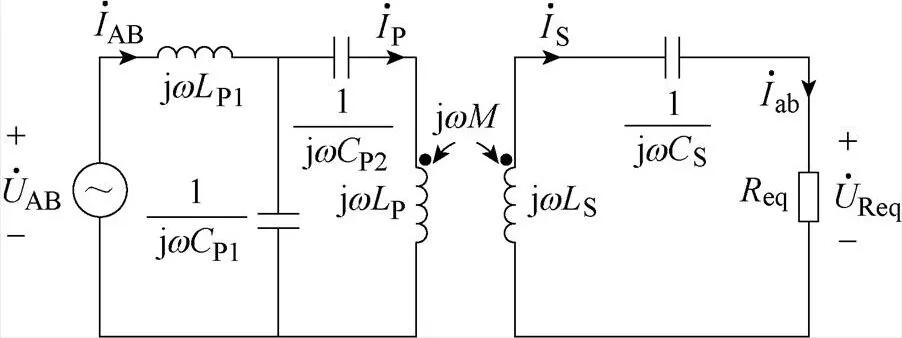
图2 基于LCC/S补偿拓扑的IPT系统等效电路

LCC/S补偿拓扑的每个元件的两端电压为



1.2 传统完全谐振补偿方法输出特性分析
传统的补偿参数设计方法采用完全谐振的思想。当系统处于完全谐振状态时,满足
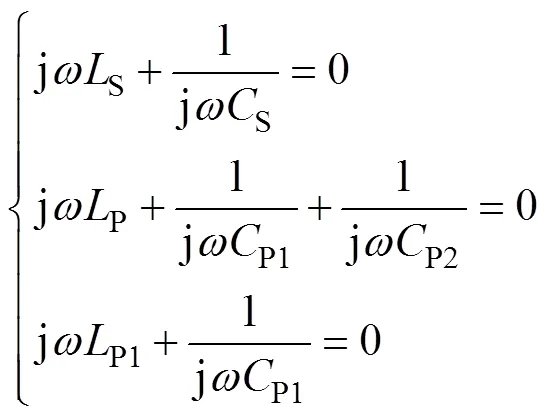
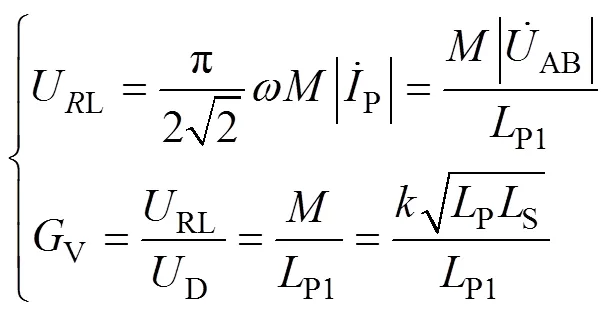
式中,为IPT系统的耦合系数。由式(8)可知,IPT系统的电压增益不受负载影响,但与互感成正比。当IPT系统工作在完全谐振状态时,LCC/S补偿拓扑的4个参数需满足
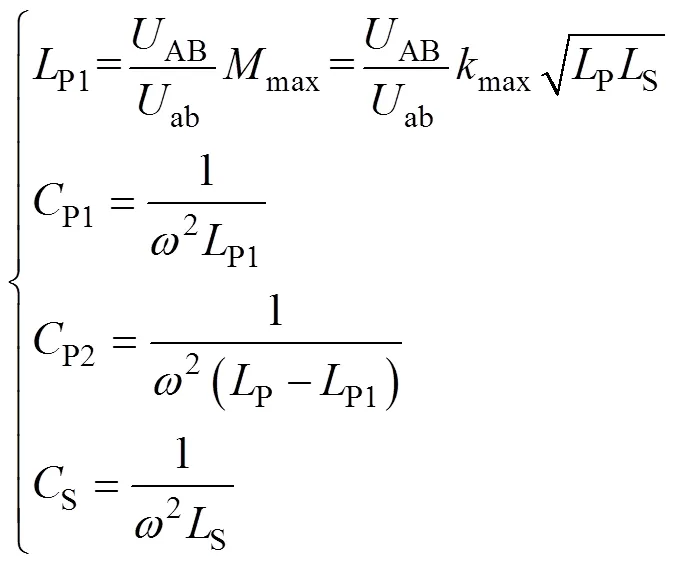
2 耦合无关恒压输出型补偿拓扑优化模型
2.1 多目标优化问题描述
为了实现耦合无关恒压输出,同时确保系统高效运行,需要建立IPT系统多目标优化模型。多目标优化问题由优化变量、目标函数、系统方程和约束条件组成。通用的多目标优化模型的简要描述为


2.2 多目标优化建模
2.2.1 目标函数
1)减小输出电压波动


2)减小电感电流应力



3)减小输入阻抗角

减小输入阻抗角的函数描述为


2.2.2 约束条件
1)电压约束
每个电容器都有相应的最大耐压值,如果电压超过了极限,电容器就容易击穿。电容器两端的电压受以下条件的限制

2)电流约束
每个电感都有相应的最大允许通过电流值,如果电流超过了这个极限,电感就容易发生短路。通过电感器的电流受以下条件的限制

3)零电压开关约束
为了减少开关损耗,提高IPT系统效率,系统应工作在零电压软开关(Zero Voltage Switching, ZVS)条件下,即IPT系统的输入阻抗应为感性。输入阻抗角用角度表示,其数学表达式为

有约束优化问题可以转化为无约束优化问题进行求解。无约束优化问题的目标函数为有约束优化问题的目标函数加上相关惩罚项。对于可行域外的解,惩罚项为正,即对该粒子进行惩罚;对于可行域内的解,惩罚项为0,即不做任何惩罚。因此惩罚项促使无约束优化问题的解落在可行域内。对于电容电压应力约束,罚函数定义为

同理,对于电感电流应力约束,罚函数定义为

对于零电压开关约束,罚函数定义为


2.3 多目标优化问题求解
2.3.1 MOPSO算法流程



C. A. C. Coello等在PSO算法中引入Pareto最优求解多目标优化问题,称为MOPSO算法。MOPSO算法流程如图3所示,步骤如下:①参数初始化;②速度和位置更新;③适应度计算;④个体最优位置更新;⑤档案更新;⑥全局最优向量更新;⑦重复步骤②~步骤⑥,直到满足循环条件结束[28-29]。其中,步骤⑤档案更新共包括三轮:首先,根据支配关系进行第一轮粒子群筛选,可得到Pareto最优解集并存入档案库;然后,根据支配关系对档案库的粒子群进行筛选,去除劣解;最后,若种群数量超过存档阈值,则根据自适应网格法进行清除,网格将被重新划分[28-29]。
2.3.2 求解空间和最大粒子速度



图3 MOPSO算法流程

根据式(28)和式(29),可得到多目标粒子群优化(MOPSO)算法的补偿参数求解空间为
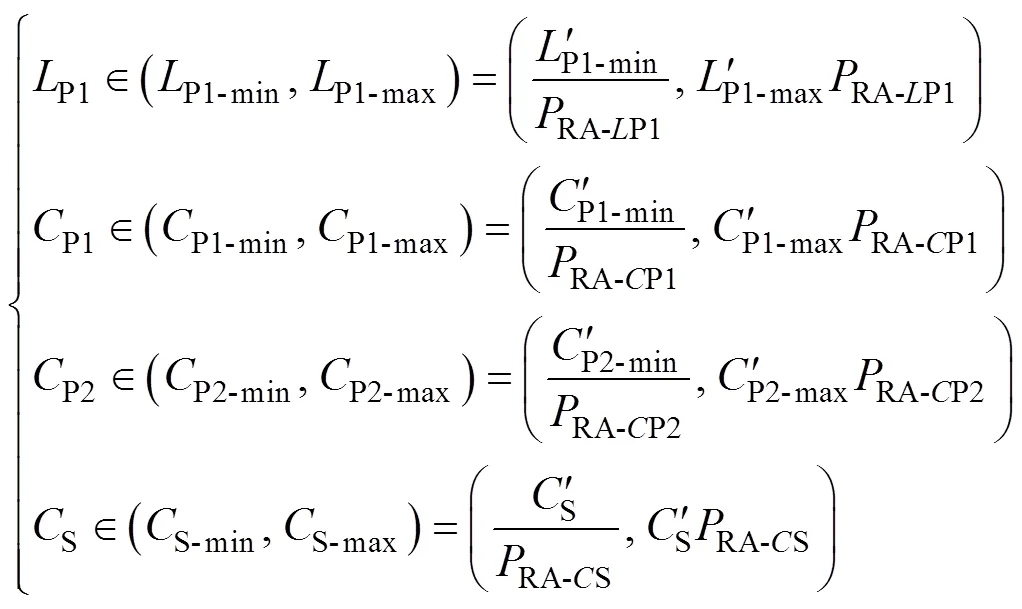

3 优化实例和性能分析
3.1 优化实例


表1 IPT系统相关参数
将表1的参数代入式(9),可得到基于LCC/S补偿的IPT系统在完全谐振下的补偿拓扑参数,见表2。根据式(28)、式(29)和表1的参数可得到求解空间参考值,见表2。此外,MOPSO算法的相关参数设置值见表3。
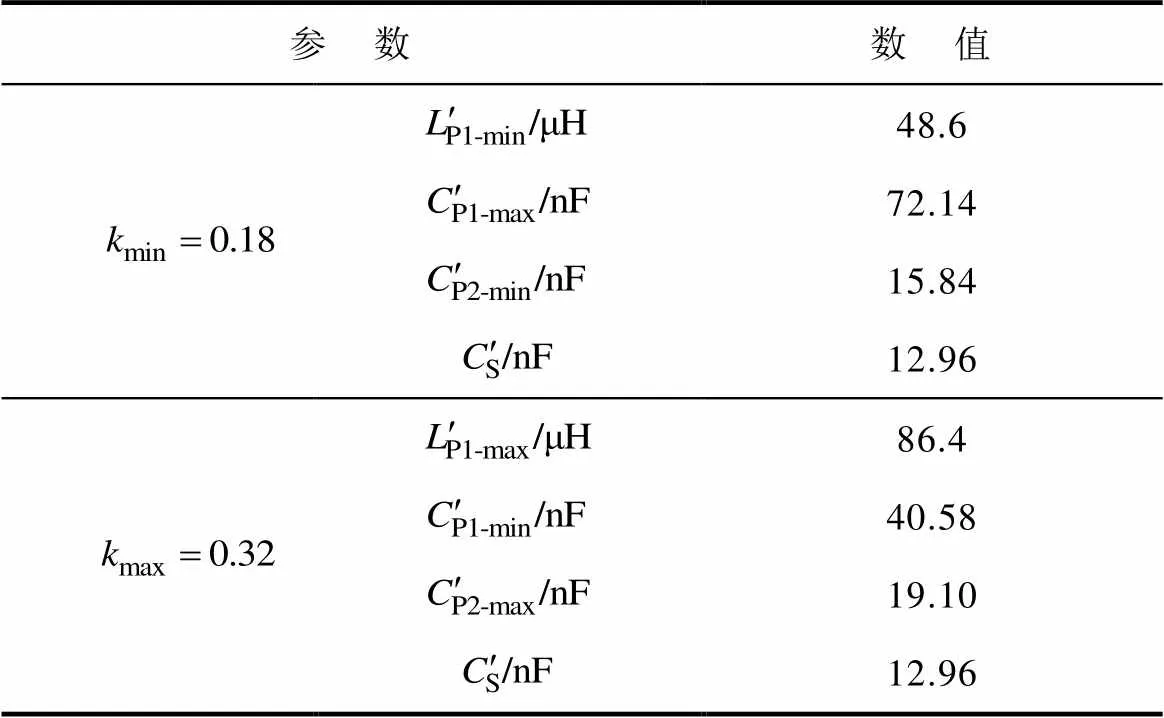
表2 传统的参数值和解空间的参考值

表3 MOPSO算法的相关参数
3.2 收敛和敏感度分析
基于MOPSO算法得到的Pareto前沿收敛过程如图4所示,随着迭代次数的增加,Pareto前沿逐渐“减小”,分布逐渐变得光滑均匀,优化结果逐渐收敛。当迭代次数为80时,帕累托前沿基本固定,并与迭代次数为200时的帕累托前沿重叠如图8所示,表明MOPSO算法求解该多目标优化模型的收敛速度较快。
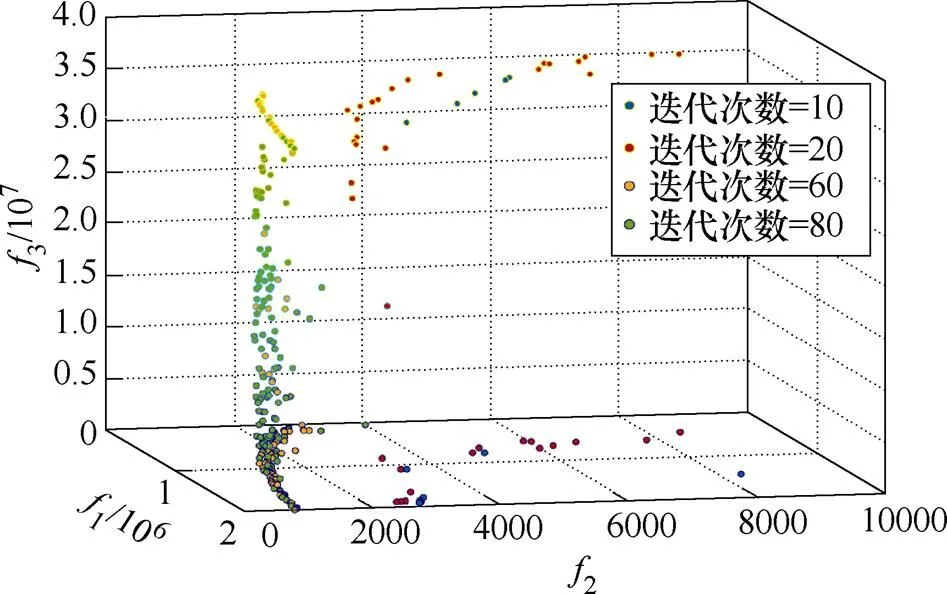
图4 MOPSO算法的收敛性
当输入电压变化时,IPT系统的Pareto前沿对比如图5所示。当输入电压从80 V增大到120 V时,Pareto前沿几乎重合,三种不同输入电压的适应度函数值接近。在不同输出电压要求下,IPT系统的Pareto前沿对比如图6所示。当输出电压在80~120 V范围内变化时,Pareto前沿变化趋势一致,均能够获得较好的适应度函数值。因此,MOPSO算法对输入和输出变量变化不敏感,所建立的多目标优化模型与MOPSO算法具有较好的兼容性。

图5 不同输入电压下的Pareto解
3.3 Pareto最优结果
MOPSO算法经过200次迭代,档案库中先后生成的所有解如图7所示(3D图)。整个算法运行时间约为20 s,最终计算结果收敛到Pareto前沿,如图8所示(2D图)。

图6 不同输出电压下的Pareto解

图7 200次迭代的所有解

图8 Pareto最优解
3.4 仿真分析
从图8可以看出,电压波动和电感电流应力不能同时达到最优,而输入阻抗角(Input Impedance Angle, IIA)与两者没有呈正相关或负相关。因此,以电压波动最小为最高优先级,以电感电流应力和输入阻抗角为主要参考因素,在解A附近选择三个相邻解,分别用方案Ⅰ、方案Ⅱ和方案Ⅲ表示,相关参数见表4。不同耦合系数和负载下的输出电压、输入阻抗角、电感电流应力和电容电压应力分别如图9~图12所示。选定方案与传统方案进行的比较和分析结果见表5。


表4 基于权衡分析法选择的解决方案

表5 传统方案和选定方案对比
4 实验验证
4.1 实验装置
为了验证所提方法有效性,搭建了实验样机并与传统方案进行比较。虽然方案Ⅱ的电压波动率VFR小于方案Ⅲ,但方案Ⅱ的4个补偿参数值都大于方案Ⅲ。受补偿元件尺寸、体积和成本的限制,补偿参数值不能太大,优化方案Ⅲ更加实用。因此,仅对传统方案和方案Ⅲ进行验证和对比分析。

4.2 实验结果


图13 IPT系统实验样机

图14 实验波形和DC-DC效率

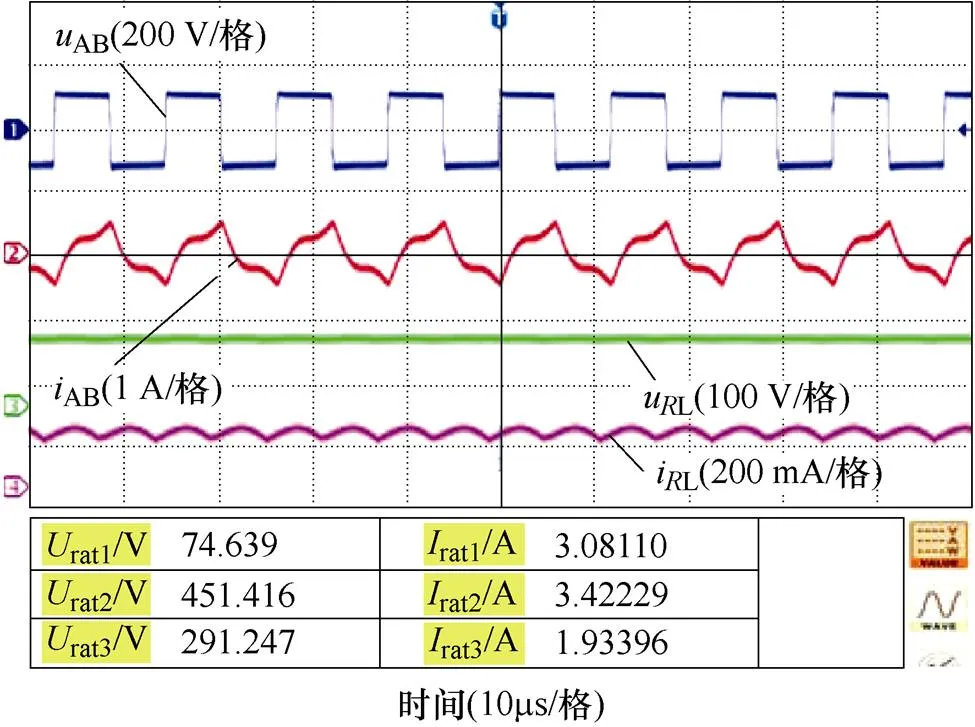



图15 实验波形和元器件应力
Fig.15 Experimental waveforms and component stresses

(a)传统方案
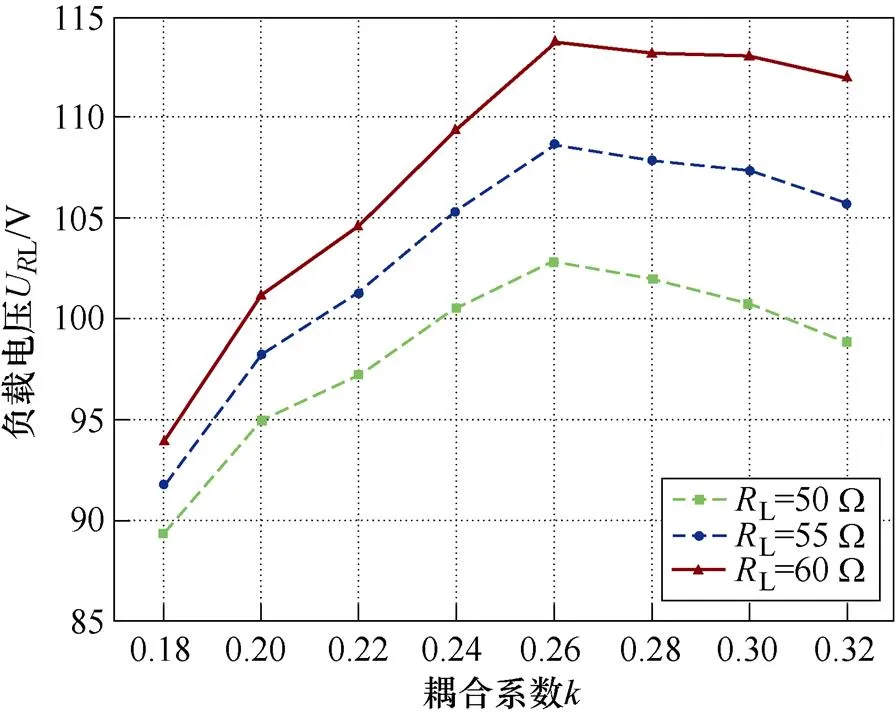
(b)优化方案
图16 输出电压随耦合系数和负载变化曲线
Fig.16 Output voltage versus coupling coefficient and load

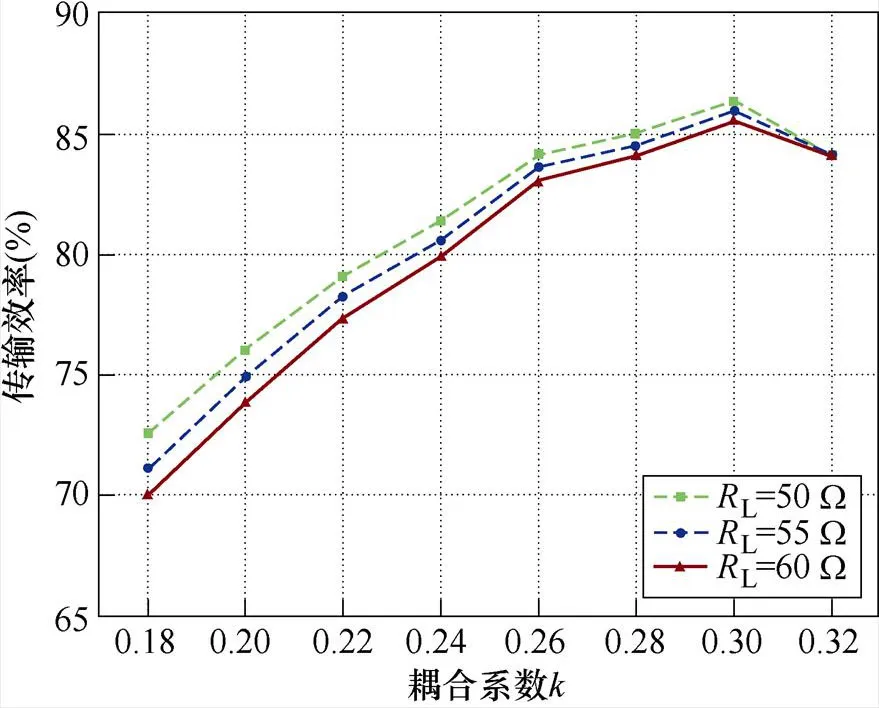
(a)传统方案

(b)优化方案
图17 效率随耦合系数和负载变化曲线
Fig.17 Efficiency versus coupling coefficient and load
综上所述,优化方案的输出电压波动、DC-DC效率均优于传统方案。实验与理论分析基本一致,从而验证了基于多目标优化理论的补偿拓扑参数设计方法的有效性。基于传统补偿方法的IPT系统发射线圈电流与负载和耦合系数无关,系统的输出电压对耦合系数非常敏感。基于多目标优化方法的IPT系统的发射线圈电流与耦合系数呈负相关,可以跟踪和补偿耦合系数对IPT系统输出电压的影响。优化方案的补偿参数值均小于传统方案的补偿参数值,相应的寄生电阻也小于传统方案。优化方案的发射线圈电流与耦合系数呈负相关,使得接收线圈电流基本不变。因此,优化方案能够在耦合系数和负载变化范围内高效运行。此外,通过合理的开关选择方案可以进一步降低逆变器、整流器等开关元件的损耗,不在本文讨论范围之内。
5 结论

[1] Zhang Zhen, Pang Hongliang, Georgiadis A, et al. Wireless power transfer-an overview[J]. IEEE Transactions on Industrial Electronics, 2019, 66(2): 1044-1058.
[2] 薛明, 杨庆新, 章鹏程, 等. 无线电能传输技术应用研究现状与关键问题[J]. 电工技术学报, 2021, 36(8): 1547-1568.
Xue Ming, Yang Qingxin, Zhang Pengcheng, et al. Application status and key issues of wireless power transmission technology[J]. Transactions of China Electrotechnical Society, 2021, 36(8): 1547-1568.
[3] Covic G A, Boys J T. Inductive power transfer[J]. Proceedings of the IEEE, 2013, 101(6): 1276-1289.
[4] Li Zhenjie, Zhu Chunbo, Jiang Jinhai, et al. A 3-kW wireless power transfer system for sightseeing car supercapacitor charge[J]. IEEE Transactions on Power Electronics, 2017, 32(5): 3301-3316.
[5] 陈凯楠, 蒋烨, 檀添, 等. 轨道交通350kW大功率无线电能传输系统研究[J]. 电工技术学报, 2022, 37(10): 2411-2421, 2445.
Chen Kainan, Jiang Ye, Tan Tian, et al. Research on 350kW high power wireless power transfer system for rail transit[J]. Transactions of China Electro- technical Society, 2022, 37(10): 2411-2421, 2445.
[6] 谢文燕, 陈为. 基于组合补偿网络的抗偏移恒流输出无线电能传输系统研究[J]. 电工技术学报, 2022, 37(6): 1495-1512.
Xie Wenyan, Chen Wei. Research on anti-offset constant-current output wireless power transfer system based on combined compensation network[J]. Transactions of China Electrotechnical Society, 2022, 37(6): 1495-1512.
[7] 孙淑彬, 张波, 李建国, 等. 多负载磁耦合无线电能传输系统的拓扑发展和分析[J]. 电工技术学报, 2022, 37(8): 1885-1903.
Sun Shubin, Zhang Bo, Li Jianguo, et al. Analysis and development on topologies of multi-load magnetic- coupling wireless power transfer system[J]. Transa- ctions of China Electrotechnical Society, 2022, 37(8): 1885-1903.
[8] Vu V B, Ramezani A, Triviño A, et al. Operation of inductive charging systems under misalignment conditions: a review for electric vehicles[J]. IEEE Transactions on Transportation Electrification, 2022, 9(1): 1857-1887.
[9] 陈阳, 杨斌, 彭云尔, 等. 感应式无线电能传输系统抗偏移技术研究综述[J]. 中国电机工程学报, 2023, 43(14): 5537-5559.
Chen Yang, Yang Bin, Peng Yuner, et al. Review of anti-misalignment technology in inductive wireless power transfer system[J]. Proceedings of the CSEE, 2023, 43(14): 5537-5559.
[10] 陆远方, 黎祎阳, 杨斌, 等. 考虑线圈参数变化的SS型动态无线电能传输系统参数优化设计方法[J].电工技术学报, 2022, 37(18): 4537-4547.
Lu Yuanfang, Li Yiyang, Yang Bin, et al. Parameter design method for SS compensated dynamic wireless power transfer system considering coils’ parameters variations[J]. Transactions of China Electrotechnical Society, 2022, 37(18): 4537-4547.
[11] 张献, 韩大稳, 沙琳, 等. 一种共享磁通多耦合模式的无线电能传输系统抗偏移方法[J]. 电工技术学报, 2022, 37(21): 5359-5368.
Zhang Xian, Han Dawen, Sha Lin, et al. An anti- offset method under flux-sharing multi-coupling mode for wireless power transmission system[J]. Transactions of China Electrotechnical Society, 2022, 37(21): 5359-5368.
[12] 陈永洪, 黎祎阳, 杨斌, 等. 基于多中继线圈结构的无线电能传输系统恒流/恒压输出方法[J]. 电力系统自动化, 2022, 46(20): 147-154.
Chen Yonghong, Li Yiyang, Yang Bin, et al. Constant-current/constant-voltage output method for wireless power transfer system based on multi-relay coil structure[J]. Automation of Electric Power Systems, 2022, 46(20): 147-154.
[13] 胡秀芳, 王跃, 吕双庆, 等. 基于谐波状态空间的无线电能传输系统建模和稳定性分析[J]. 电力系统自动化, 2022, 46(11): 121-130.
Hu Xiufang, Wang Yue, Lü Shuangqing, et al. Modeling and stability analysis of wireless power transfer system based on harmonic state space[J]. Automation of Electric Power Systems, 2022, 46(11): 121-130.
[14] 王党树, 董振, 古东明, 等. 基于双边LCL变补偿参数谐振式无线充电系统的研究与分析[J]. 电工技术学报, 2022, 37(16): 4019-4028.
Wang Dangshu, Dong Zhen, Gu Dongming, et al. Research and analysis of resonant wireless charging system based on bilateral LCL variable compensation parameters[J]. Transactions of China Electrotechnical Society, 2022, 37(16): 4019-4028.
[15] Dai Zhongyu, Wang Junhua, Zhou Haikuo, et al. A review on the recent development in the design and optimization of magnetic coupling mechanism of wireless power transmission[J]. IEEE Systems Journal, 2020, 14(3): 4368-4381.
[16] Li Weihan, Zhao Han, Deng Junjun, et al. Comparison study on SS and double-sided LCC compensation topologies for EV/PHEV wireless chargers[J]. IEEE Transactions on Vehicular Technology, 2016, 65(6): 4429-4439.
[17] Liu Y C, Zhang Jiantao, Tse C K, et al. General pathways to higher order compensation circuits for IPT converters via sensitivity analysis[J]. IEEE Transactions on Power Electronics, 2021, 36(9): 9897-9906.
[18] Borage M, Tiwari S, Kotaiah S. Analysis and design of an LCL-T resonant converter as a constant-current power supply[J]. IEEE Transactions on Industrial Electronics, 2005, 52(6): 1547-1554.
[19] Zhao Lei, Thrimawithana D J, Madawala U K. Hybrid bidirectional wireless EV charging system tolerant to pad misalignment[J]. IEEE Transactions on Industrial Electronics, 2017, 64(9): 7079-7086.
[20] Villa J L, Sallan J, Sanz Osorio J F, et al. High- misalignment tolerant compensation topology for ICPT systems[J]. IEEE Transactions on Industrial Electronics, 2012, 59(2): 945-951.
[21] Mai Ruikun, Chen Yang, Li Yong, et al. Inductive power transfer for massive electric bicycles charging based on hybrid topology switching with a single inverter[J]. IEEE Transactions on Power Electronics, 2017, 32(8): 5897-5906.
[22] Feng Hao, Cai Tao, Duan Shanxu, et al. A dual-side detuned series-series compensated resonant converter for wide charging region in a wireless power transfer system[J]. IEEE Transactions on Industrial Elec- tronics, 2018, 65(3): 2177-2188.
[23] 任洁, 刘野然, 岳鹏飞, 等. 基于参数优化法的输出抗偏移感应电能传输系统研究[J]. 中国电机工程学报, 2019, 39(5): 1452-1461.
Ren Jie, Liu Yeran, Yue Pengfei, et al. Study on anti-misalignment inductive power transfer system based on parameter optimized method[J]. Proceedings of the CSEE, 2019, 39(5): 1452-1461.
[24] Feng Hao, Cai Tao, Duan Shanxu, et al. An LCC compensated resonant converter optimized for robust reaction to large coupling variation in dynamic wireless power transfer[J]. IEEE Transactions on Industrial Electronics, 2016, 63(10): 6591-6601.
[25] Yao Yousu, Wang Yijie, Liu Xiaosheng, et al. Particle swarm optimization-based parameter design method for S/CLC-compensated IPT systems featuring high tolerance to misalignment and load variation[J]. IEEE Transactions on Power Electronics, 2019, 34(6): 5268-5282.
[26] Ramezani A, Narimani M. Optimized electric vehicle wireless chargers with reduced output voltage sensitivity to misalignment[J]. IEEE Journal of Emerging and Selected Topics in Power Electronics, 2020, 8(4): 3569-3581.
[27] Chen Weiming, Lu Weiguo, Iu H H C. Compensation network optimal design based on evolutionary algorithm for inductive power transfer system[J]. IEEE Transactions on Circuits and Systems I: Regular Papers, 2020, 67(12): 5664-5674.
[28] Coello C A C, Lechuga M S. MOPSO: a proposal for multiple objective particle swarm optimization[C]// Proceedings of the 2002 Congress on Evolutionary Computation, Honolulu, HI, USA, 2002: 1051-1056.
[29] Coello C A C, Pulido G T, Lechuga M S. Handling multiple objectives with particle swarm optimi- zation[J]. IEEE Transactions on Evolutionary Com- putation, 2004, 8(3): 256-279.
Coupling-Independent Constant-Voltage Output LCC/S Compensation Inductive Power Transfer System Based on Multi-Objective Optimization Theory
11122
(1. School of Electrical Engineering Beijing Jiaotong University Beijing 100044 China 2. China Electric Power Research Institute Beijing 100192 China)
The inductive power transfer (IPT) system based on the traditional full resonance parameter design method presents the best performance only when the transmitting and receiving coils are fully coupled. Usually, the primary coil is fixed, and the position of the secondary coil is uncertain for human factors, causing lateral and longitudinal misalignment of the magnetic coupling mechanism. This misalignment of the magnetic coupling mechanism directly leads to the variation of the coupling coefficient, which may lead to a wide range of output voltage fluctuation and efficiency reduction. To obtain a relatively constant output voltage and operate efficiently under coupling coefficient and load variations, this paper overcomes the limitations of the traditional full resonance parameter design method, transforming the compensation topology parameter design problem into a multi-objective optimization problem.
Firstly, after analyzing full resonance compensation parameters, the system equations of the IPT system with LCC/S compensation topology are established using the fundamental harmonic approximation (FHA) method. A multi-objective optimization model is established. Herein, compensation topology parameters are used as optimization variables, and output voltage fluctuation reduction and system efficiency improvement are as the optimization objectives. The constraints are maximum inductance passing current, maximum capacitor withstanding voltage, and zero voltage switching (ZVS). Then, a case is designed, and the multi-objective particle swarm optimization (MOPSO) algorithm is used to solve the multi-objective optimization model. Three optimization schemes are selected from the Pareto optimal solution set according to the actual needs, and the simulation analysis is carried out. Finally, based on the multi-objective optimization theory, an experimental platform is built to verify the coupling-independent constant output characteristics and efficient operation characteristics of the compensation parameter design method. The experimental results show that when the coupling coefficient of the IPT system varies in the range of 0.20~0.32, and the equivalent load resistance varies in the range of 50~60W, the output voltage fluctuation rate (VFR) of the optimized scheme is less than 9.0%. In the whole range of coupling coefficient and load variation, the minimum efficiency is 87.5%, and the maximum efficiency is 93.2%. Compared with the efficiency of the traditional scheme (70.0%~86.3%), the efficiency of the optimized scheme is also greatly improved.
Different from single-objective optimization, which provides only a single solution, the multi-objective optimization model established in this paper can get the Pareto optimal solution set through the MOPSO algorithm. The decision maker determines the weight of each object according to the actual needs and selects the appropriate design scheme from the Pareto optimal solution set. Thus, the IPT system can still obtain a relatively constant output voltage and operate efficiently when the coupling coefficient and load change. This method has high flexibility and wide applicability. It is suitable for optimizing compensation topologies that satisfy features like coupling and load-independent constant output, high efficiency, low device stress, zero voltage switching, and more.
Inductive power transfer, multi-objective optimization, coupling-independent constant voltage output, multi-objective particle swarm optimization (MOPSO) algorithm, Pareto solutions
TM724
10.19595/j.cnki.1000-6753.tces.230325
中央高校基本科研业务费专项资金资助项目(2023JBZX006)。
2023-03-20
2023-06-02
焦超群 男,1976年生,副教授,博士生导师,研究方向为电磁场理论及其应用、大功率IGBT器件、无线电能传输技术等。E-mail: chqjiao@bjtu.edu.cn
杨 旭 男,1987年生,博士研究生,研究方向电力电子变换器、无线电能传输技术等。E-mail: yangxuican@bjtu.edu.cn(通信作者)
(编辑 陈 诚)

